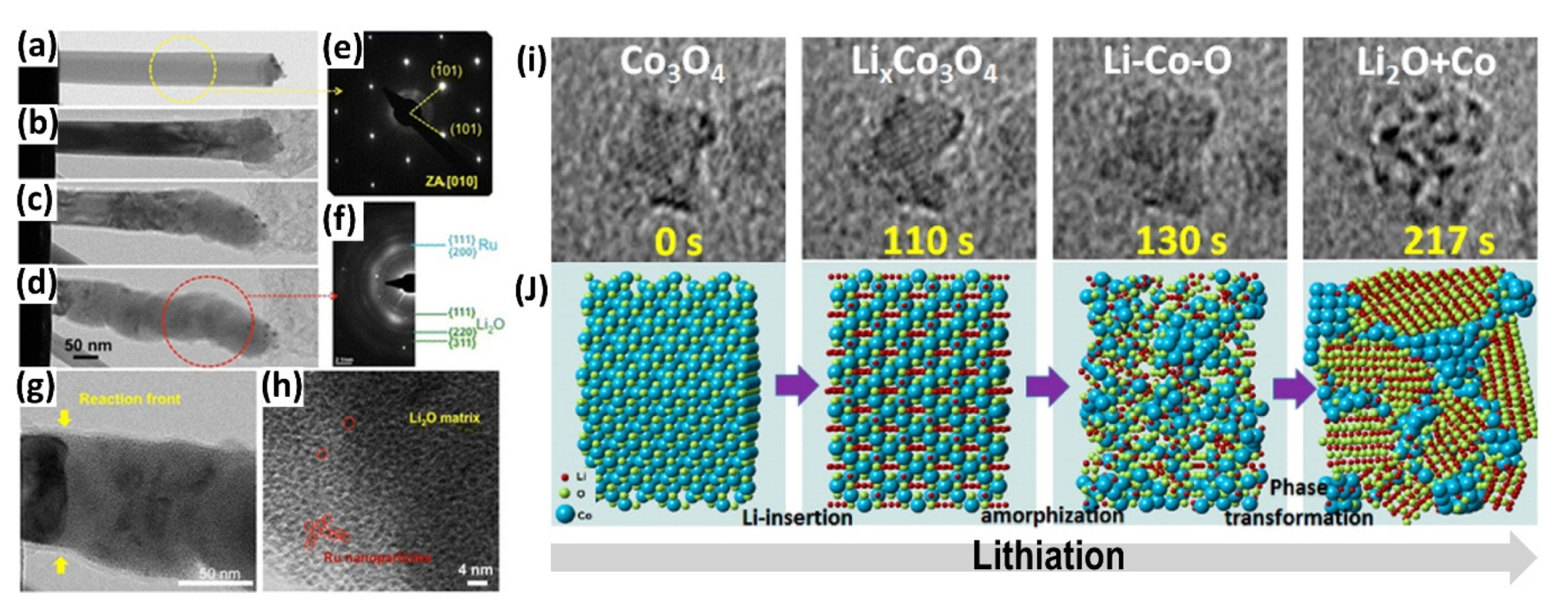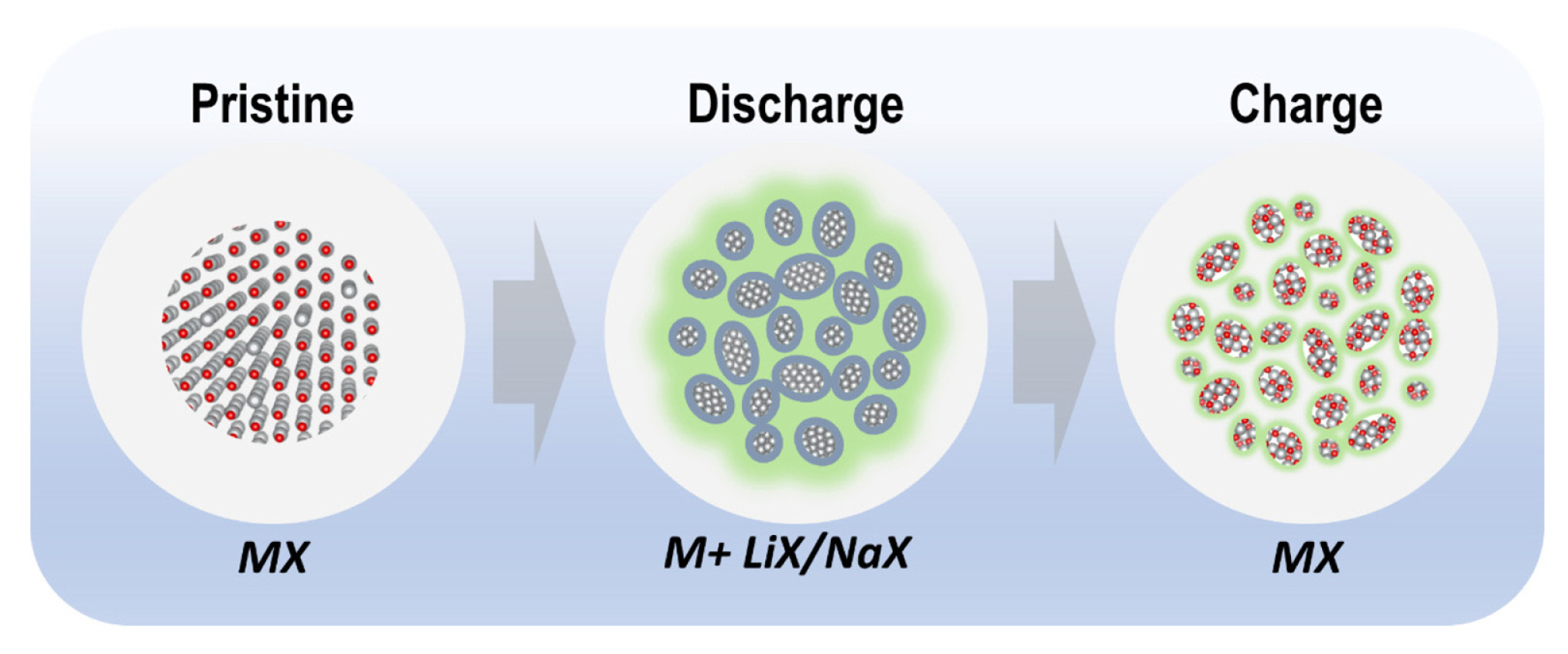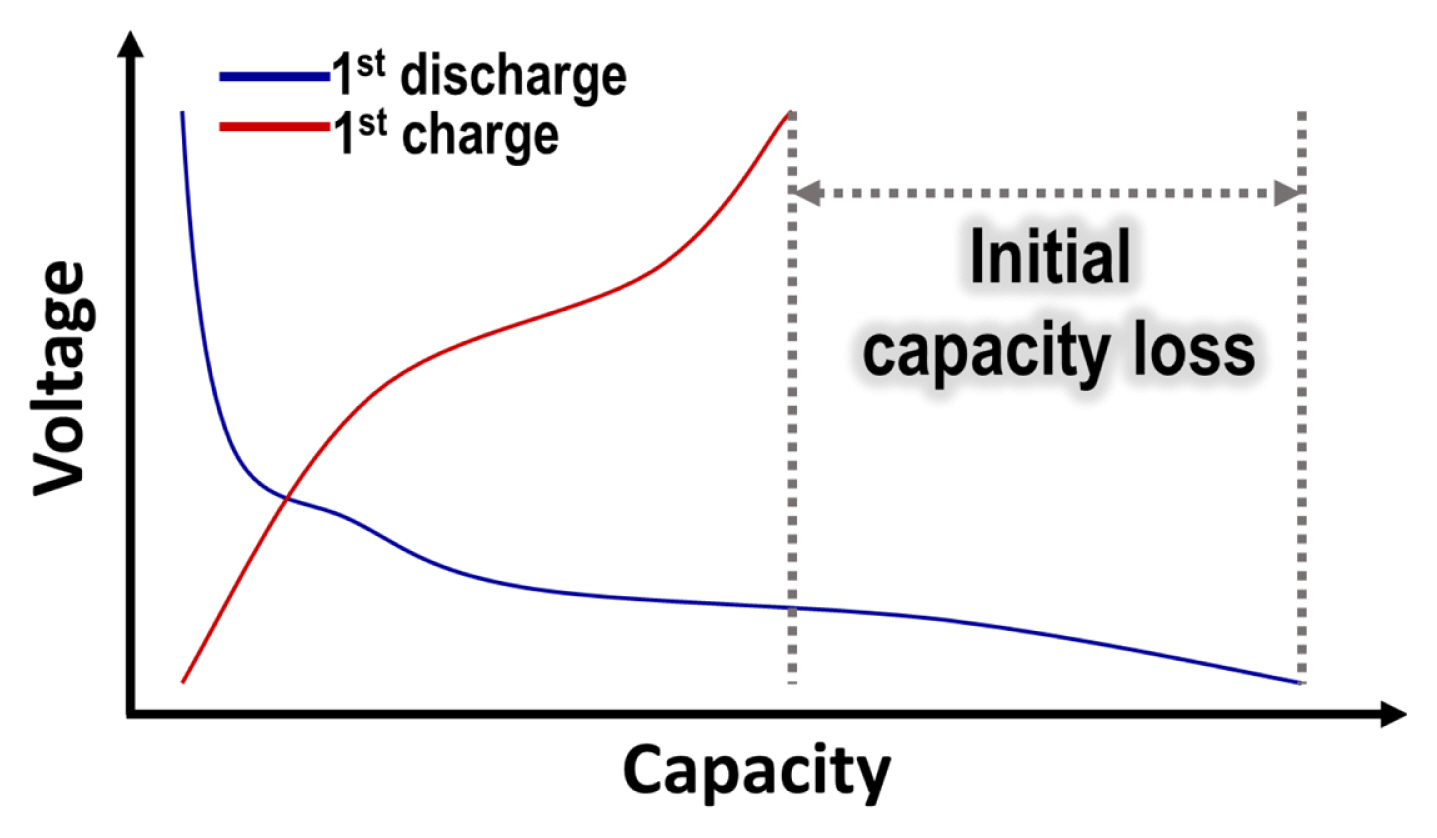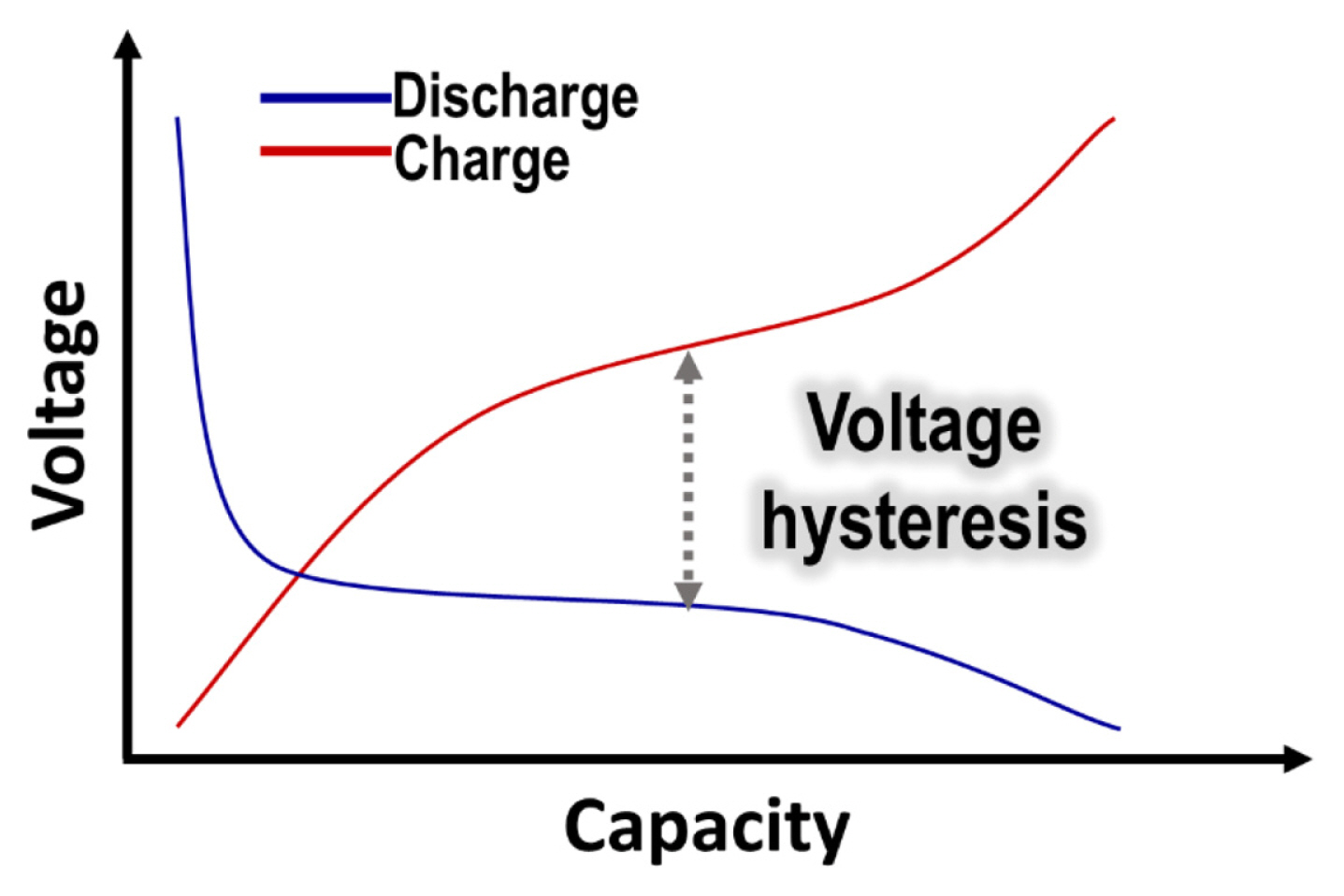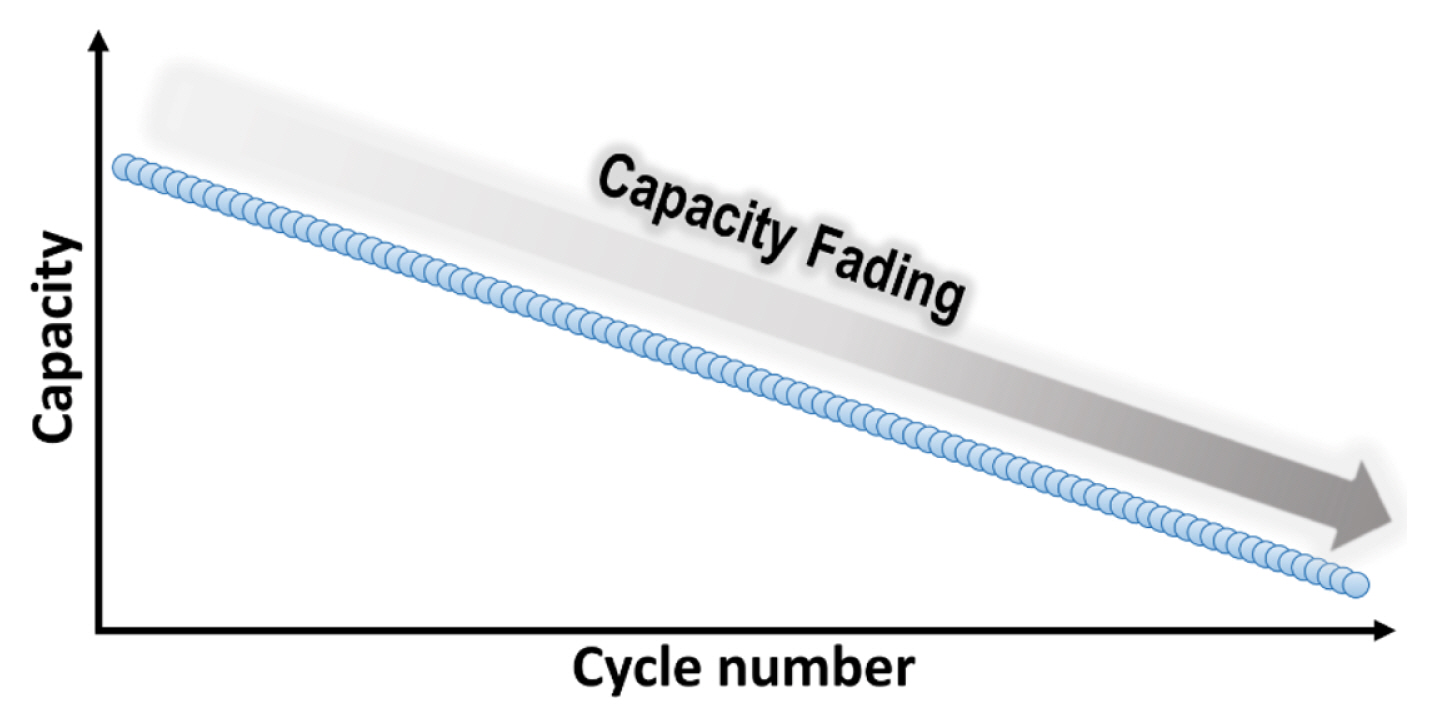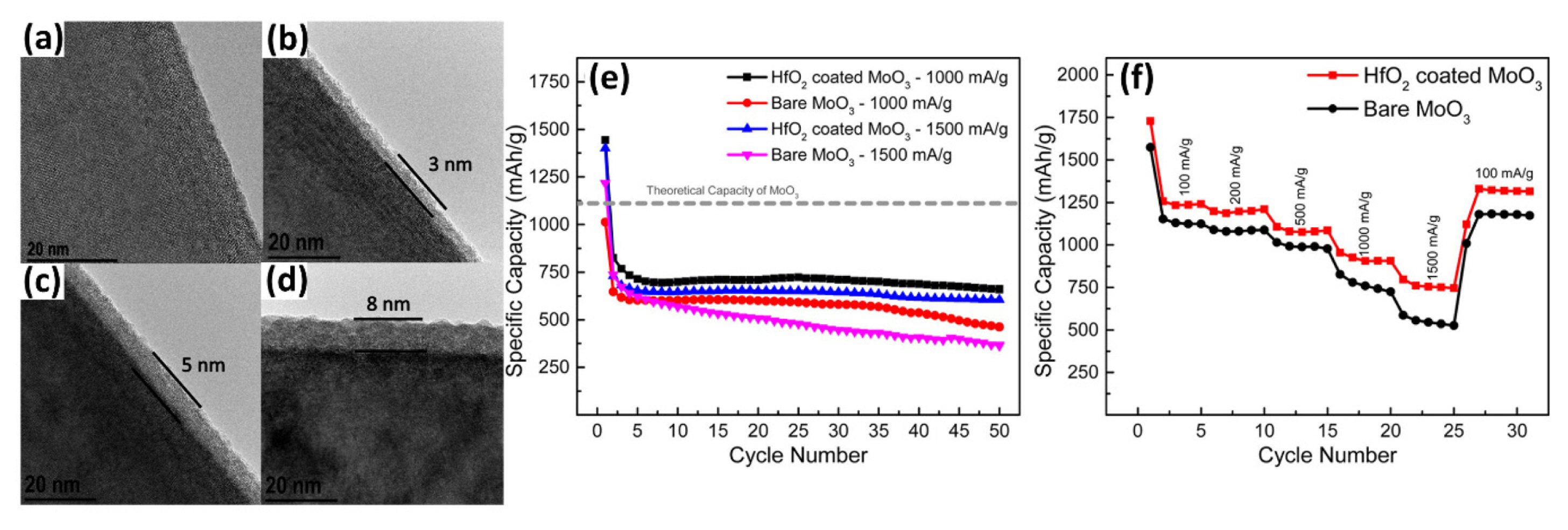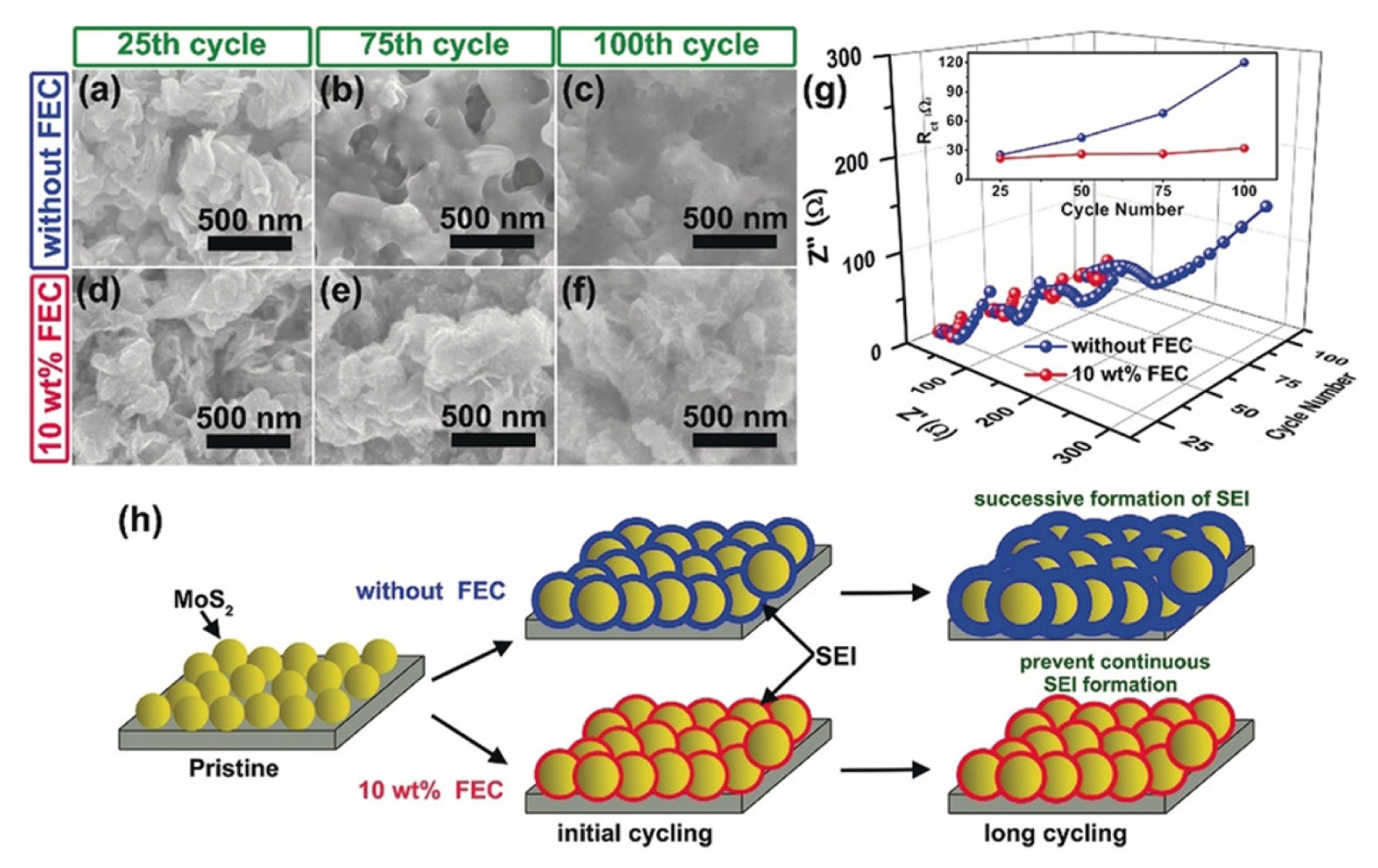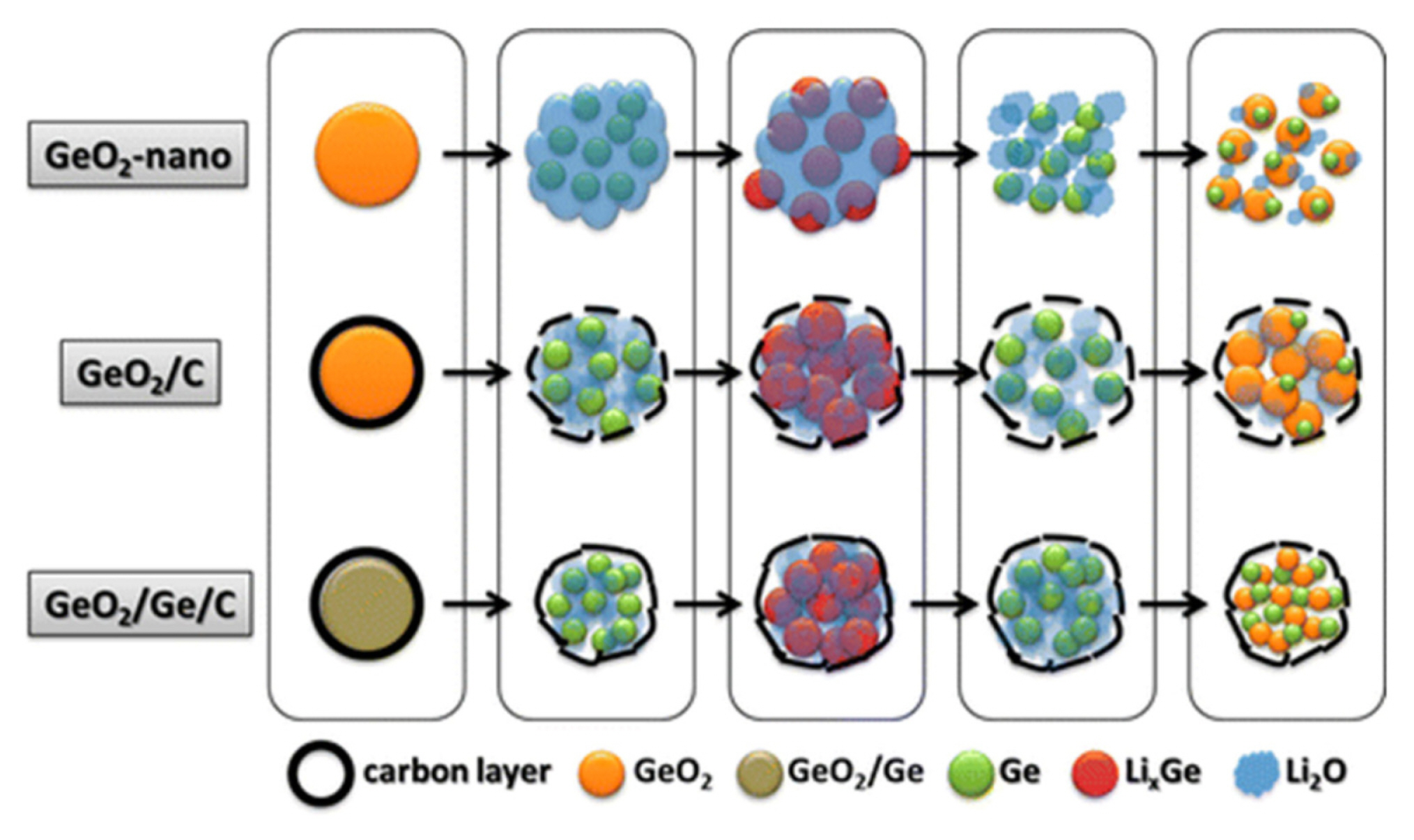[1] JM. Tarascon and M. Armand,
Nature,
2001,
414, 359–367.


[2] B. Scrosati, J. Hassoun and YK. Sun,
Energy Environ Sci,
2011,
4(
9), 3287–3295.

[3] MS. Whittingham,
Chem Rev,
2004,
104(
10), 4271–4301.

[4] K. Chayambuka, G. Mulder, DL. Danilov and PHL. Notten,
Adv Energy Mater,
2018,
8(
16), 1800079.

[5] MD. Slater, D. Kim, E. Lee and CS. Johnson,
Adv Funct Mater,
2013,
23(
8), 947–958.

[6] MS. Whittingham,
Science,
1976,
192(
4244), 1126–1127.

[7] K. Mizushima, PC. Jones, PJ. Wiseman and JB. Goodenough,
Mater Res Bull,
1980,
15(
6), 783–789.

[8] A. Yoshino, K. Sanechika and T. Nakajima,
Geothermics,
1987,
14(
4), 595–599.

[9] AK. Padhi, KS. Nanjundaswamy and JB. Goodenough,
J Electrochem Soc,
1997,
144(
4), 1188–1194.

[10] S. Chae, S. Choi, N. Kim, J. Sung and J. Cho,
Angew Chem Int Ed,
2020,
59(
1), 110–135.

[11] J. Cabana, L. Monconduit, D. Larcher and MR. Palacín,
Adv Mater,
2010,
22(
35), E170–E192.

[12] SH. Yu, SH. Lee, DJ. Lee, YE. Sung and T. Hyeon,
Small,
2016,
12(
16), 2146–2172.

[13] P. Poizot, S. Laruelle, S. Grugeon, L. Dupont and J-M. Tarascon,
Nature,
2000,
407, 496–499.


[14] Mv. Reddy, Gv. Subba Rao and BVR. Chowdari,
Chem Rev,
2013,
113(
7), 5364–5457.

[15] Y. Lu, L. Yu and XW. (David) Lou,
Chem,
2018,
4(
5), 972–996.

[16] SW. Kim, DH. Seo, X. Ma, G. Ceder and K. Kang,
Adv Energy Mater,
2012,
2(
7), 710–721.

[17] X. Wei, X. Wang, X. Tan, Q. An and L. Mai,
Adv Funct Mater,
2018,
28(
46), 1804458.

[18] Y. Jiang, M. Hu, D. Zhang, T. Yuan, W. Sun, B. Xu and M. Yan,
Nano Energy,
2014,
5, 60–66.

[19] J. Yang, S. Muhammad, MR. Jo, H. Kim, K. Song, DA. Agyeman, Y. Kim il, W-S. Yoon and YM. Kang,
Chem Soc Rev,
2016,
45(
20), 5717–5770.

[20] S-M. Bak, Z. Shadike, R. Lin, X. Yu and X-Q. Yang,
NPG Asia Mater,
2018,
10, 563–580.


[21] J. Cui, H. Zheng and K. He,
Adv Mater,
2021,
33(
6), 2000699.

[22] X. Ou, J. Li, F. Zheng, P. Wu, Q. Pan, X. Xiong, C. Yang and M. Liu,
J Power Sources,
2017,
343, 483–491.

[23] J. Yang, T. Zhou, R. Zhu, X. Chen, Z. Guo, J. Fan, HK. Liu and WX. Zhang,
Adv Mater Interfaces,
2016,
3(
3), 1500464.

[24] H. Kim, W. Choi, J. Yoon, E. Lee and W-S. Yoon,
Small,
2021,
17(
14), 2006433.

[25] J. Li, D. Yan, T. Lu, Y. Yao and L. Pan,
Chem Eng J,
2017,
325, 14–24.

[26] MK. Kim, SH. Yu, A. Jin, J. Kim, IH. Ko, KS. Lee, J. Mun and YE. Sung,
Chem Commun,
2016,
52(
79), 11775–11778.

[27] J. Li, S. Hwang, F. Guo, S. Li, Z. Chen, R. Kou, K. Sun, CJ. Sun, H. Gan, A. Yu, EA. Stach, H. Zhou and D. Su, Nat Commun, 2019, 10, 2224.
[28] KH. Nam and CM. Park,
J Mater Chem A,
2016,
4(
22), 8562–8565.

[29] H. Kim, H. Kim, GO. Park, Y. Kim, S. Muhammad, J. Yoo, M. Balasubramanian, YH. Cho, MG. Kim, B. Lee, K. Kang, JM. Kim and W-S. Yoon,
Chem Mater,
2014,
26(
22), 6361–6370.

[30] MA. Lowe, J. Gao and HD. Abruña,
J Mater Chem A,
2013,
1(
6), 2094–2103.

[31] U. Boesenberg, MA. Marcus, AK. Shukla, T. Yi, E. McDermott, PF. Teh, M. Srinivasan, A. Moewes and J. Cabana, Sci Rep, 2014, 4, 7133.
[32] L. Li, R. Jacobs, P. Gao, L. Gan, F. Wang, D. Morgan and S. Jin,
J Am Chem Soc,
2016,
138(
8), 2838–2848.

[33] J. Jang, JH. Ku, SM. Oh and T. Yoon,
ACS Appl Mater Interfaces,
2021,
13(
8), 9814–9819.

[34] J. Yoon, W. Choi, T. Kim, H. Kim, Y. Seok Choi, J. Man Kim and W-S. Yoon,
J Energy Chem,
2021,
53, 276–284.

[35] Y. Li, H. Sun, X. Cheng, Y. Zhang and K. Zhao,
Nano Energy,
2016,
27, 95–102.

[36] SY. Lee, L. Wu, AS. Poyraz, J. Huang, AC. Marschilok, KJ. Takeuchi, ES. Takeuchi, M. Kim and Y. Zhu,
Adv Mater,
2017,
29(
43), 1703186.

[37] R. Cai, S. Guo, Y. Wu, S. Zhang, Y. Sun, S. Chen, P. Gao, C. Zhu, J. Chen, Z. Zhu, L. Sun and F. Xu,
Energy Storage Mater,
2021,
37, 345–353.

[38] C. Zhu, F. Xu, H. Min, Y. Huang, W. Xia, Y. Wang, Q. Xu, P. Gao and L. Sun,
Adv Funct Mater,
2017,
27(
17), 1606163.

[39] W. Tang, CX. Peng, CT. Nai, J. Su, YP. Liu, MVV. Reddy, M. Lin and KP. Loh,
Small,
2015,
11(
20), 2446–2453.

[40] SJ. Rezvani, R. Gunnella, A. Witkowska, F. Mueller, M. Pasqualini, F. Nobili, S. Passerini and A. di Cicco,
ACS Appl Mater Interfaces,
2017,
9(
5), 4570–4576.

[41] R. Dedryvère, S. Laruelle, S. Grugeon, P. Poizot, D. Gonbeau and JM. Tarascon,
Chem Mater,
2004,
16(
6), 1056–1061.

[42] L. Martin, H. Martinez, D. Poinot, B. Pecquenard and F. le Cras,
J Power Sources,
2014,
248, 861–873.

[43] YY. Hu, Z. Liu, KW. Nam, OJ. Borkiewicz, J. Cheng, X. Hua, MT. Dunstan, X. Yu, KM. Wiaderek, LS. Du, KW. Chapman, PJ. Chupas, XQ. Yang and CP. Grey,
Nat Mater,
2013,
12, 1130–1136.


[44] X. Hua, PK. Allan, C. Gong, PA. Chater, EM. Schmidt, HS. Geddes, AW. Robertson, PG. Bruce and AL. Goodwin, Nat Commun, 2021, 12, 561.
[45] OJ. Borkiewicz, KW. Chapman and PJ. Chupas,
Phys Chem Chem Phys,
2013,
15(
22), 8466–8469.

[46] H. Kim, W. Choi, J. Yoon, JH. Um, W. Lee, J. Kim, J. Cabana and W-S. Yoon,
Chem Rev,
2020,
120(
14), 6934–6976.

[47] M. Keppeler and M. Srinivasan,
ChemElectroChem,
2017,
4(
11), 2727–2754.

[48] S. Laruelle, S. Grugeon, P. Poizot, M. Dollé, L. Dupont and J-M. Tarascon,
J Electrochem Soc,
2002,
149(
5), A627–A634.

[49] J. Jamnik and J. Maier,
Phys Chem Chem Phys,
2003,
5(
23), 5215–5220.

[50] P. Balaya, H. Li, L. Kienle and J. Maier,
Adv Funct Mater,
2003,
13(
8), 621–625.

[51] H. Kim, WI. Choi, Y. Jang, M. Balasubramanian, W. Lee, GO. Park, SB. Park, J. Yoo, JS. Hong, YS. Choi, HS. Lee, IT. Bae, JM. Kim and W-S. Yoon,
ACS Nano,
2018,
12(
3), 2909–2921.

[52] NA. Kaskhedikar and J. Maier,
Adv Mater,
2009,
21(
25–26), 2664–2680.

[53] JK. Shon, HS. Lee, GO. Park, J. Yoon, E. Park, GS. Park, SS. Kong, M. Jin, JM. Choi, H. Chang, S. Doo, JM. Kim, W-S. Yoon, C. Pak, H. Kim and GD. Stucky, Nat Commun, 2016, 7, 11049.
[54] Q. Li, J. Wu, Z. Yao, Y. Xu, MM. Thackeray, C. Wolverton and VP. Dravid,
Nano Energy,
2018,
44, 15–22.

[55] K. He, HL. Xin, K. Zhao, X. Yu, D. Nordlund, TC. Weng, J. Li, Y. Jiang, CA. Cadigan, RM. Richards, MM. Doeff, XQ. Yang, EA. Stach, J. Li, F. Lin and D. Su,
Nano Lett,
2015,
15(
2), 1437–1444.

[56] KE. Gregorczyk, Y. Liu, JP. Sullivan and GW. Rubloff,
ACS Nano,
2013,
7(
7), 6354–6360.

[57] L. Luo, J. Wu, J. Xu and VP. Dravid,
ACS Nano,
2014,
8(
11), 11560–11566.

[58] S. Grugeon, S. Laruelle, R. Herrera-Urbina, L. Dupont, P. Poizot and J-M. Tarascon,
J Electrochem Soc,
2001,
148(
4), A285–A292.

[59] Y. Zeng, L. Li, H. Li, X. Huang and L. Chen,
Ionics,
2009,
15, 91–96.


[60] DC. Bock, GH. Waller, AN. Mansour, AC. Marschilok, KJ. Takeuchi and ES. Takeuchi,
J Phys Chem C,
2018,
122(
26), 14257–14271.

[61] K. Zhou, S. Wang, S. Zhang, F. Kang and B. Li,
J Mater Chem A,
2020,
8(
28), 14031–14042.

[62] F. Gong, Q. Zhou, J. Liu, D. Wang, S. Wu and DD. Xia,
Energy and Fuels,
2020,
34(
6), 7616–7621.

[63] T. Zhu, Y. Wang, Y. Li, R. Cai, J. Zhang, C. Yu, J. Wu, J. Cui, Y. Zhang, PM. Ajayan and Y. Wu,
ACS Appl Nano Mater,
2020,
3(
10), 10369–10379.

[64] C. He, S. Wu, N. Zhao, C. Shi, E. Liu and J. Li,
ACS Nano,
2013,
7(
5), 4459–4469.

[65] J. Zhu, W. Tu, H. Pan, H. Zhang, B. Liu, Y. Cheng, Z. Deng and H. Zhang,
ACS Nano,
2020,
14(
5), 5780–5787.

[66] M. Jing, M. Zhou, G. Li, Z. Chen, W. Xu, X. Chen and Z. Hou,
ACS Appl Mater Interfaces,
2017,
9(
11), 9662–9668.

[67] W. Zhang, J. Sheng, J. Zhang, T. He, L. Hu, R. Wang, L. Mai and S. Mu,
J Mater Chem A,
2016,
4(
43), 16936–16945.

[68] Y. Kim, J. Yoon, GO. Park, S. bin Park, H. Kim, JM. Kim and W-S. Yoon,
J Power Sources,
2018,
396, 749–753.

[69] H. Kim, H. Kim, S. Muhammad, JH. Um, MSA. Sher Shah, PJ. Yoo and W-S. Yoon,
J Power Sources,
2020,
446, 227321.

[70] M. Xu, Q. Xia, J. Yue, X. Zhu, Q. Guo, J. Zhu and H. Xia,
Adv Funct Mater,
2019,
29(
6), 1807377.

[71] B. Wang, EH. Ang, Y. Yang, Y. Zhang, H. Geng, M. Ye and CC. Li,
Adv Funct Mater,
2020,
30(
28), 2001708.

[72] N. Zhang, X. Han, Y. Liu, X. Hu, Q. Zhao and J. Chen,
Adv Energy Mater,
2015,
5(
5), 1401123.

[73] S. Peng, L. Li, SG. Mhaisalkar, M. Srinivasan, S. Ramakrishna and Q. Yan,
ChemSusChem,
2014,
7(
8), 2212–2220.

[74] Y. Lian, F. Chen, H. Kang, C. Wu, M. Zhang and S. Xu,
Appl Surf Sci,
2020,
507, 145061.

[75] G. Ke, H. Chen, J. He, X. Wu, Y. Gao, Y. Li, H. Mi, Q. Zhang, C. He and X. Ren,
Chem Eng J,
2021,
403, 126251.

[76] JS. Cho, JS. Park and YC. Kang,
Nano Res,
2017,
10(
3), 897–907.


[77] Y. Liu, N. Zhang, H. Kang, M. Shang, L. Jiao and J. Chen,
Chem Eur J,
2015,
21(
33), 11878–11884.

[78] D. Chen, G. Chen, J. Pei, Y. Hu, Z. Qin, J. Wang and F. Wu,
ChemElectroChem,
2017,
4(
9), 2158–2163.

[79] H. Chen, G. Ke, X. Wu, W. Li, H. Mi, Y. Li, L. Sun, Q. Zhang, C. He and X. Ren,
Nanoscale,
2021,
13(
6), 3782–3789.

[80] D. Ma, Q. Zhu, X. Li, H. Gao, X. Wang, X. Kang and Y. Tian,
ACS Appl Mater Interfaces,
2019,
11(
8), 8009–8017.

[81] F. Niu, J. Yang, N. Wang, D. Zhang, W. Fan, J. Yang and Y. Qian,
Adv Funct Mater,
2017,
27(
23), 1700522.

[82] JS. Cho, SY. Lee, JK. Lee and YC. Kang,
ACS Appl Mater Interfaces,
2016,
8(
33), 21343–21349.

[83] G. Jiang, H. Han, W. Zhuang, X. Xu, S. Kaskel, F. Xu and H. Wang,
J Mater Chem A,
2019,
7(
29), 17561–17569.

[84] Y. Dong, Y. Li, H. Shi, J. Qin, S. Zheng, R. He and ZS. Wu,
Carbon,
2020,
159, 213–220.

[85] V. Sridhar and H. Park,
J Alloys Compd,
2019,
808, 151748.

[86] J. Yang, Y. Zhang, C. Sun, H. Liu, L. Li, W. Si, W. Huang, Q. Yan and X. Dong,
Nano Res,
2016,
9(
3), 612–621.


[87] GA. Li, CY. Wang, WC. Chang and HY. Tuan,
ACS Nano,
2016,
10(
9), 8632–8644.

[88] X. Zhu, Y. Zhong, H. Zhai, Z. Yan and D. Li,
Electrochim Acta,
2014,
132, 364–369.

[89] C. Li, Z. Xue, J. Qin, M. Sawangphruk, P. Yu, X. Zhang and R. Liu,
J Alloys Compd,
2020,
842, 155812.

[90] L. Su, Z. Zhou, X. Qin, Q. Tang, D. Wu and P. Shen,
Nano Energy,
2013,
2(
2), 276–282.

[91] X. Feng, Q. Shen, Y. Shi and J. Zhang,
Electrochim Acta,
2016,
220, 391–397.

[92] X. Gu, C. Yan, L. Yan, L. Cao, F. Niu, D. Liu, P. Dai, L. Li, J. Yang and X. Zhao,
J Mater Chem A,
2017,
5(
47), 24645–24650.

[93] S. Wu, M. Lu, X. Tian and C. Jiang,
Chem Eng J,
2017,
313, 610–618.

[94] J. Yao, T. Jin, Y. Li, S. Xiao, B. Huang and J. Jiang,
J Alloys Compd,
2021,
886, 161238.

[95] Y. Sharma, N. Sharma, GVS. Rao and BVR. Chowdari,
J Power Sources,
2007,
173(
1), 495–501.

[96] K. Zhang, Y. Li, X. Hu, F. Liang, L. Wang, R. Xu, Y. Dai and Y. Yao,
Chem Eng J,
2021,
404, 126464.

[97] CH. Jo, H. Yashiro, S. Yuan, L. Shi and ST. Myung,
ACS Appl Mater Interfaces,
2018,
10(
47), 40523–40530.

[98] JH. Um, H. Kim, Y-H. Cho and W-S. Yoon,
J Electrochem Sci Technol,
2020,
11(
1), 92–98.


[99] SW. Lee, CW. Lee, SB. Yoon, MS. Kim, JH. Jeong, KW. Nam, KC. Roh and KB. Kim,
J Power Sources,
2016,
312, 207–215.

[100] Y. Kim, S. Muhammad, H. Kim, Y-H. Cho, H. Kim, JM. Kim and W-S. Yoon,
ChemSusChem,
2015,
8(
14), 2378–2384.

[101] F. Klein, B. Jache, A. Bhide and P. Adelhelm,
Phys Chem Chem Phys,
2013,
15(
38), 15876–15887.

[102] S. Fang, D. Bresser and S. Passerini,
Adv Energy Mater,
2020,
10(
1), 1902485.

[103] S. Hariharan, K. Saravanan, V. Ramar and P. Balaya,
Phys Chem Chem Phys,
2013,
15(
8), 2945–2953.

[104] W. Xia, F. Xu, C. Zhu, HL. Xin, Q. Xu, P. Sun and L. Sun,
Nano Energy,
2016,
27, 447–456.

[105] Z. Liu, M. Qin, S. Guo, C. Li, Q. Su, X. Cao, G. Fang and S. Liang,
Mater Chem Front,
2021,
5(
4), 1694–1715.

[106] X. Huang, Z. Zeng and H. Zhang,
Chem Soc Rev,
2013,
42(
5), 1934–1946.

[107] XY. Yu, L. Yu and XW. Lou,
Adv Energy Mater,
2016,
6(
3), 1501333.

[108] K. Edström, M. Herstedt and DP. Abraham,
J Power Sources,
2006,
153(
2), 380–384.

[109] S. Dai, L. Wang, M. Cao, Z. Zhong, Y. Shen and M. Wang,
Mater Today Energy,
2019,
12, 114–128.

[110] A. Débart, L. Dupont, R. Patrice and JM. Tarascon,
Solid State Sci,
2006,
8(
6), 640–651.

[111] GL. Xu, T. Sheng, L. Chong, T. Ma, CJ. Sun, X. Zuo, DJ. Liu, Y. Ren, X. Zhang, Y. Liu, SM. Heald, SG. Sun, Z. Chen and K. Amine,
Nano Lett,
2017,
17(
2), 953–962.

[112] Y. Zhou, D. Yan, H. Xu, J. Feng, X. Jiang, J. Yue, J. Yang and Y. Qian,
Nano Energy,
2015,
12, 528–537.

[113] S. Li, P. Liu, X. Huang, Y. Tang and H. Wang,
J Mater Chem A,
2019,
7(
18), 10988–10997.

[114] Z. Ali, M. Asif, X. Huang, T. Tang and Y. Hou,
Adv Mater,
2018,
30(
36), 1802745.

[115] YN. Ko, SH. Choi and YC. Kang,
ACS Appl Mater Interfaces,
2016,
8(
10), 6449–6456.

[116] X. Yang, J. Zhang, Z. Wang, H. Wang, C. Zhi, DYW. Yu and AL. Rogach,
Small,
2018,
14(
7), 1702669.

[117] C. Han, Z. Li, WJ. Li, SL. Chou and SX. Dou,
J Mater Chem A,
2014,
2(
30), 11683–11690.

[118] MS. Balogun, Y. Huang, W. Qiu, H. Yang, H. Ji and Y. Tong,
Mater Today,
2017,
20(
8), 425–451.

[119] M. Idrees, A. Mukhtar, . Ata-ur-Rehman, SM. Abbas, Q. Zhang and X. Li,
Mater Today Commun,
2021,
27, 102363.

[120] X. Li, C. Deng, H. Wang, J. Si, S. Zhang and B. Huang,
ACS Appl Mater Interfaces,
2021,
13(
6), 7297–7307.

[121] J. Fullenwarth, A. Darwiche, A. Soares, B. Donnadieu and L. Monconduit,
J Mater Chem A,
2014,
2(
7), 2050–2059.

[122] KH. Kim and SH. Hong,
Adv Energy Mater,
2021,
11(
9), 2003609.

[123] S. Zhao, Z. Wang, Y. He, H. Jiang, YW. Harn, X. Liu, C. Su, H. Jin, Y. Li, S. Wang, Q. Shen and Z. Lin,
Adv Energy Mater,
2019,
9(
26), 1901093.

[124] WA. Ang, N. Gupta, R. Prasanth and S. Madhavi,
ACS Appl Mater Interfaces,
2012,
4(
12), 7011–7019.

[125] L. Su, J. Hei, X. Wu, L. Wang and Z. Zhou,
Adv Funct Mater,
2017,
27(
10), 1605544.

[126] Y. Zhang, C. Wang, Y. Dong, R. Wei and J. Zhang,
Chem Eur J,
2021,
27(
3), 993–1001.

[127] L. Wang, W. Tang, Y. Jing, L. Su and Z. Zhou,
ACS Appl Mater Interfaces,
2014,
6(
15), 12346–12352.

[128] B. Philippe, M. Valvo, F. Lindgren, H. Rensmo and K. Edström,
Chem Mater,
2014,
26(
17), 5028–5041.

[129] YX. Lin, Z. Liu, K. Leung, LQ. Chen, P. Lu and Y. Qi,
J Power Sources,
2016,
309, 221–230.

[130] B. Philippe, M. Hahlin, K. Edström, T. Gustafsson, H. Siegbahn and H. Rensmo,
J Electrochem Soc,
2016,
163(
2), A178–A191.

[131] C. Xiao, R. Usiskin and J. Maier,
Adv Funct Mater,
2021,
31(
25), 2100938.

[132] Y. Kim, JH. Lee, S. Cho, Y. Kwon, I. In, J. Lee, NH. You, E. Reichmanis, H. Ko, KT. Lee, HK. Kwon, DH. Ko, H. Yang and B. Park,
ACS Nano,
2014,
8(
7), 6701–6712.

[133] S. Permien, S. Indris, AL. Hansen, M. Scheuermann, D. Zahn, U. Schürmann, G. Neubüser, L. Kienle, E. Yegudin and W. Bensch,
ACS Appl Mater Interfaces,
2016,
8(
24), 15320–15332.

[134] JH. Um, K. Palanisamy, M. Jeong, H. Kim and W-S. Yoon,
ACS Nano,
2019,
13(
5), 5674–5685.

[135] E. Ventosa, W. Xia, S. Klink, F. la Mantia, M. Muhler and W. Schuhmann,
Electrochim Acta,
2012,
65, 22–29.

[136] W. Xing,
J Electrochem Soc,
1997,
144(
4), 1195–1201.

[137] G. Ramos-Sanchez, G. Chen, AR. Harutyunyan and PB. Balbuena,
RSC Adv,
2016,
6(
33), 27260–27266.

[138] K. Omichi, G. Ramos-Sanchez, R. Rao, N. Pierce, G. Chen, PB. Balbuena and AR. Harutyunyan,
J Electrochem Soc,
2015,
162(
10), A2106–A2115.

[139] A. Kraytsberg and Y. Ein-Eli,
J Solid State Electrochem,
2017,
21, 1907–1923.


[140] C. Wu, SX. Dou and Y. Yu,
Small,
2018,
14(
22), 1703671.

[141] YT. Lee, CT. Kuo and TR. Yew,
ACS Appl Mater Interfaces,
2021,
13(
1), 570–579.

[142] P. Liu, JJ. Vajo, JS. Wang, W. Li and J. Liu,
J Phys Chem C,
2012,
116(
10), 6467–6473.

[143] H. Kim, H. Kim, H. Kim, J. Kim, G. Yoon, K. Lim, W-S. Yoon and K. Kang,
Adv Funct Mater,
2016,
26(
28), 5042–5050.

[144] S. Li, Z. Shadike, G. Kwon, XQ. Yang, JH. Lee and S. Hwang,
Chem Mater,
2021,
33(
10), 3515–3523.

[145] D. Chang, MH. Chen and A. van der Ven,
Chem Mater,
2015,
27(
22), 7593–7600.

[146] T. Takeuchi, H. Sakaebe, H. Kageyama, T. Sakai and K. Tatsumi,
J Electrochem Soc,
2008,
155(
9), A679–A684.

[147] J. Zhang, P. Gu, J. Xu, H. Xue and H. Pang,
Nanoscale,
2016,
8(
44), 18578–18595.

[148] B. Cao, Z. Liu, C. Xu, J. Huang, H. Fang and Y. Chen,
J Power Sources,
2019,
414, 233–241.

[149] Z. Zhang, W. Li, T-W. Ng, W. Kang, C-S. Lee and W. Zhang,
J Mater Chem A,
2015,
3(
41), 20527–20534.

[150] H. Sun, G. Xin, T. Hu, M. Yu, D. Shao, X. Sun and J. Lian, Nat Commun, 2014, 5, 4526.
[151] J. Yoon, W. Choi, H. Kim, YS. Choi, JM. Kim and W-S. Yoon,
J Power Sources,
2021,
493, 229682.

[152] Z. Li, Y. Fang, J. Zhang and XW. (David) Lou,
Adv Mater,
2018,
30(
30), 1800525.

[153] H. Kim, N. Venugopal, J. Yoon and W-S. Yoon,
J Alloys Compd,
2019,
778, 37–46.

[154] R. Zhao, Q. Li, C. Wang and L. Yin,
Electrochim Acta,
2016,
197, 58–67.

[155] S. Zhang, BVR. Chowdari, Z. Wen, J. Jin and J. Yang,
ACS Nano,
2015,
9(
12), 12464–12472.

[156] L. Yu, JF. Yang and XWD. Lou,
Angew Chem Int Ed,
2016,
55(
43), 13422–13426.

[157] K. Xu, X. Shen, C. Song, H. Chen, Y. Chen, Z. Ji, A. Yuan, X. Yang and L. Kong,
Small,
2021,
17(
34), 2101080.

[158] W. Chen, X. Zhang, L. Mi, C. Liu, J. Zhang, S. Cui, X. Feng, Y. Cao and C. Shen,
Adv Mater,
2019,
31(
8), 1806664.

[159] Y. Meng, Y. Cheng, X. Ke, G. Ren and F. Zhu,
J Electrochem Sci Technol,
2021,
12(
2), 285–295.


[160] S. Tian, B. Li, B. Zhang, Y. Wang, X. Yang, H. Ye, Z. Xia and G. Zheng, J Electrochem Sci Technol, 2020, 11(4), 384–391.
[161] R. Raccichini, A. Varzi, S. Passerini and B. Scrosati,
Nat Mater,
2015,
14, 271–279.


[162] W. Zhao, W. Choi and W-S. Yoon,
J Electrochem Sci Technol,
2020,
11(
3), 195–219.


[163] G. Zhou, DW. Wang, LC. Yin, N. Li, F. Li and HM. Cheng,
ACS Nano,
2012,
6(
4), 3214–3223.

[164] XY. Shan, G. Zhou, LC. Yin, WJ. Yu, F. Li and HM. Cheng,
J Mater Chem A,
2014,
2(
42), 17808–17814.

[165] RW. Johnson, A. Hultqvist and SF. Bent,
Mater Today,
2014,
17(
5), 236–246.

[166] QH. Wu, B. Qu, J. Tang, C. Wang, D. Wang, Y. Li and JG. Ren,
Electrochim Acta,
2015,
156, 147–153.

[167] E. Kang, YS. Jung, AS. Cavanagh, GH. Kim, SM. George, AC. Dillon, JK. Kim and J. Lee,
Adv Funct Mater,
2011,
21(
13), 2430–2438.

[168] H. Zhang, Z. Chen, R. Hu, J. Liu, J. Cui, W. Zhou and C. Yang,
J Mater Chem A,
2018,
6(
10), 4374–4385.

[169] W. Ren, W. Zhou, H. Zhang and C. Cheng,
ACS Appl Mater Interfaces,
2017,
9(
1), 487–495.

[170] N. Yesibolati, M. Shahid, W. Chen, MN. Hedhili, MC. Reuter, FM. Ross and HN. Alshareef,
Small,
2014,
10(
14), 2849–2858.

[171] B. Ahmed, DH. Anjum, MN. Hedhili and HN. Alshareef,
Small,
2015,
11(
34), 4341–4350.

[172] B. Ahmed, M. Shahid, DH. Nagaraju, DH. Anjum, MN. Hedhili and HN. Alshareef,
ACS Appl Mater Interfaces,
2015,
7(
24), 13154–13163.

[173] X. Li, J. Liu, L. Ouyang, B. Yuan, L. Yang and M. Zhu,
Appl Surf Sci,
2018,
436, 912–918.

[174] B. Wang, G. Wang, Z. Zheng, H. Wang, J. Bai and J. Bai,
Electrochim Acta,
2013,
106, 235–243.

[175] Z. Hu, H. Cui, J. Li, G. Lei and Z. Li,
Ceram Int,
2020,
46(
11), 18868–18877.

[176] H. Zhao, X. Yu, J. Li, B. Li, H. Shao, L. Li and Y. Deng,
J Mater Chem A,
2019,
7(
15), 8700–8722.

[177] L. Wang, J. Światowska, S. Dai, M. Cao, Z. Zhong, Y. Shen and M. Wang,
Mater Today Energy,
2019,
11, 46–60.

[178] V. Etacheri, O. Haik, Y. Goffer, GA. Roberts, IC. Stefan, R. Fasching and D. Aurbach,
Langmuir,
2012,
28(
1), 965–976.

[179] YB. Yohannes, SD. Lin and N-L. Wu,
J Electrochem Soc,
2017,
164(
14), A3641–A3648.

[180] Z. Zhu, Y. Tang, Z. Lv, J. Wei, Y. Zhang, R. Wang, W. Zhang, H. Xia, M. Ge and X. Chen,
Angew Chem,
2018,
130(
14), 3718–3722.

[181] X. Han and J. Sun,
Chem Commun,
2020,
56(
45), 6047–6049.

[182] V. Winkler, G. Kilibarda, S. Schlabach, Dv. Szabó, T. Hanemann and M. Bruns,
J Phys Chem C,
2016,
120(
43), 24706–24714.

[183] KH. Seng, L. Li, DP. Chen, ZX. Chen, XL. Wang, HK. Liu and ZP. Guo,
Energy,
2013,
58, 707–713.

[184] Y. Wang, X. Guo, Z. Wang, M. Lü, B. Wu, Y. Wang, C. Yan, A. Yuan and H. Yang,
J Mater Chem A,
2017,
5(
48), 25562–25573.

[185] Z. Zhang, X. Zhao and J. Li,
ChemNanoMat,
2016,
2(
3), 196–200.

[186] N. Kumar, A. Sen, K. Rajendran, R. Rameshbabu, J. Ragupathi, HA. Therese and T. Maiyalagan,
RSC Adv,
2017,
7(
40), 25041–25053.

[187] L. Zhang, Z. Wei, S. Yao, Y. Gao, X. Jin, G. Chen, Z. Shen and F. Du,
Adv Mater,
2021,
33(
20), 2100210.

[188] K. Chen, Y. Dong Noh, K. Li, S. Komarneni and D. Xue,
J Phys Chem C,
2013,
117(
20), 10770–10779.

[189] S. Hariharan, K. Saravanan and P. Balaya,
Electrochem Solid-State Lett,
2010,
13(
9), A132–A134.

[190] Y. Ma, C. Fang, B. Ding, G. Ji and JY. Lee,
Adv Mater,
2013,
25(
33), 4646–4652.

[191] A. Palmieri, S. Yazdani, R. Kashfi-Sadabad, SG. Karakalos, MT. Pettes and WE. Mustain,
J Phys Chem C,
2018,
122(
13), 7120–7127.

[192] W. Wang, J. Qin, Z. Yin and M. Cao,
ACS Nano,
2016,
10(
11), 10106–10116.

[193] P. Li, Y. Yang, S. Gong, F. Lv, W. Wang, Y. Li, M. Luo, Y. Xing, Q. Wang and S. Guo,
Nano Res,
2019,
12(
9), 2218–2223.


[194] TV. Thi, AK. Rai, J. Gim and J. Kim,
J Power Sources,
2015,
292, 23–30.

[195] DD. Vaughn, OD. Hentz, S. Chen, D. Wang and RE. Schaak,
Chem Commun,
2012,
48(
45), 5608–5610.

[196] IA. Courtney,
J Electrochem Soc,
1997,
144(
6), 2045–2052.

[197] YM. Lin, KC. Klavetter, A. Heller and CB. Mullins,
J Phys Chem Letters,
2013,
4(
6), 999–1004.

[198] J. Wu, N. Luo, S. Huang, W. Yang and M. Wei,
J Mater Chem A,
2019,
7(
9), 4574–4580.

[199] Y. Wang, ZX. Huang, Y. Shi, JI. Wong, M. Ding and HY. Yang, Sci Rep, 2015, 5, 9164.
[200] CH. Kim, YS. Jung, KT. Lee, JH. Ku and SM. Oh,
Electrochim Acta,
2009,
54(
18), 4371–4377.

[201] L. Wang, Q. Zhao, Z. Wang, Y. Wu, X. Ma, Y. Zhu and C. Cao,
Nanoscale,
2020,
12(
1), 248–255.

[202] J. Wang, L. Wang, S. Zhang, S. Liang, X. Liang, H. Huang, W. Zhou and J. Guo,
J Alloys Compd,
2018,
748, 1013–1021.

[203] KH. Seng, MH. Park, ZP. Guo, HK. Liu and J. Cho,
Nano Lett,
2013,
13(
3), 1230–1236.

[204] Q. Li, H. Li, Q. Xia, Z. Hu, Y. Zhu, S. Yan, C. Ge, Q. Zhang, X. Wang, X. Shang, S. Fan, Y. Long, L. Gu, GX. Miao, G. Yu and JS. Moodera,
Nat Mater,
2021,
20, 76–83.


[205] H. Li, Z. Hu, Q. Xia, H. Zhang, Z. Li, H. Wang, X. Li, F. Zuo, F. Zhang, X. Wang, W. Ye, Q. Li, Y. Long, Q. Li, S. Yan, X. Liu, X. Zhang, G. Yu and GX. Miao,
Adv Mater,
2021,
33(
12), 2006629.

[206] MY. Cheng, YS. Ye, TM. Chiu, CJ. Pan and BJ. Hwang,
J Power Sources,
2014,
253, 27–34.

[207] B. Chen, E. Liu, F. He, C. Shi, C. He, J. Li and N. Zhao,
Nano Energy,
2016,
26, 541–549.

[208] T. Wang, N. Zhao, C. Shi, L. Ma, F. He, C. He, J. Li and E. Liu,
J Phys Chem C,
2017,
121(
36), 19559–19567.

[209] Y. Lv, B. Chen, N. Zhao, C. Shi, C. He, J. Li and E. Liu,
Surf Sci,
2016,
651, 10–15.

[210] J. Li, W. Xu, C. Guo, M. Li and L. Zhang,
Electrochim Acta,
2018,
276, 333–342.

[211] S. Zhao, Y. Wang, R. Liu, Y. Yu, S. Wei, F. Yu and Q. Shen,
J Mater Chem A,
2015,
3(
33), 17181–17189.

[212] R. Zhang, X. Huang, D. Wang, TKA. Hoang, Y. Yang, X. Duan, P. Chen, LC. Qin and G. Wen,
Adv Funct Mater,
2018,
28(
10), 1705817.






